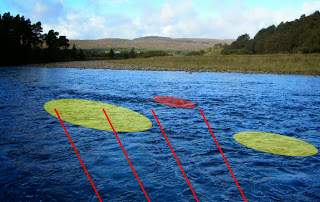Dumb Distance - or Casting without Thinking
When we first start we are keen to cast as far and as well as possible. For most men the emphasis is on the far before the well. The problem is that we are so focused on the casting that we forget that its purpose is to put the fly in front of the salmon, at the right depth and moving realistically. There's a full explanation in the Fast Food and Broad Beans post, but to recap briefly, realistic means;
- In the right direction - generally obliquely across the flow, with the fly facing somewhere in the range 10 - 70 degrees to the current. Salmon are less likely to be stimulated by objects coming straight at them or heading directly away.
- At a sensible speed - the things the salmon's brain recognises as food - nymphs, flies on the surface and small fish - do not travel at warp speed.
 This is the House Pool at Tomatin at +12" on a perfect day in mid-September. There are plenty of fish in the river and at this level they run freely (indeed they were when this photo was taken - we caught nearly 30 that week). They enter through rough fast water at the far left. Just out of shot to the right is shallow water that will cause them to check, pause and think, which is just what you want - nice alert fish in short halt lies. You're fishing from the bank in a grass meadow. Your natural urge is to fish all the water in front of you: after all, covering more water creates more chances, doesn't it? So off you go, determined to reach 30 yards and more, as marked by the red line.
This is the House Pool at Tomatin at +12" on a perfect day in mid-September. There are plenty of fish in the river and at this level they run freely (indeed they were when this photo was taken - we caught nearly 30 that week). They enter through rough fast water at the far left. Just out of shot to the right is shallow water that will cause them to check, pause and think, which is just what you want - nice alert fish in short halt lies. You're fishing from the bank in a grass meadow. Your natural urge is to fish all the water in front of you: after all, covering more water creates more chances, doesn't it? So off you go, determined to reach 30 yards and more, as marked by the red line. Then what happens? You put out a lovely cast to A and feel really pleased with yourself. Oh dear! The line swings round nicely until it checks in the dead water around the big rock in the middle. The nearer half of your line carries on downstream. Your fly (1) now starts to accelerate upstream, wasting the far 10 yards of the cast completely. You put in an upstream mend to compensate, but as the fly passes below the rock it starts to accelerate downstream (2), wasting the middle 10 yards. By the time it's sorted itself out and you've regained control, you're almost at the dangle. Out of a 30 yard cast you've had no more than 6-8 yards of effective fly movement.
Then what happens? You put out a lovely cast to A and feel really pleased with yourself. Oh dear! The line swings round nicely until it checks in the dead water around the big rock in the middle. The nearer half of your line carries on downstream. Your fly (1) now starts to accelerate upstream, wasting the far 10 yards of the cast completely. You put in an upstream mend to compensate, but as the fly passes below the rock it starts to accelerate downstream (2), wasting the middle 10 yards. By the time it's sorted itself out and you've regained control, you're almost at the dangle. Out of a 30 yard cast you've had no more than 6-8 yards of effective fly movement. Let's start again. Look at the surface of the water. You will see more movement and standing waves suggesting lies this side of the rock than beyond. Indeed, the majority of the salmon are right in front of you: I've marked 2 good lies in yellow. A series of 12-15 yard casts will cover over 60% of the fish in this picture, with your fly under control and working effectively throughout. Mathematically that gives you 8 times greater chance of catching a fish than casting 30 yards.
Let's start again. Look at the surface of the water. You will see more movement and standing waves suggesting lies this side of the rock than beyond. Indeed, the majority of the salmon are right in front of you: I've marked 2 good lies in yellow. A series of 12-15 yard casts will cover over 60% of the fish in this picture, with your fly under control and working effectively throughout. Mathematically that gives you 8 times greater chance of catching a fish than casting 30 yards.
The bottom line is that the biggest fish taken in this pool in recent years was lying about 6-8 yards out, so please engage brain and read the water before casting!
No comments:
Post a Comment